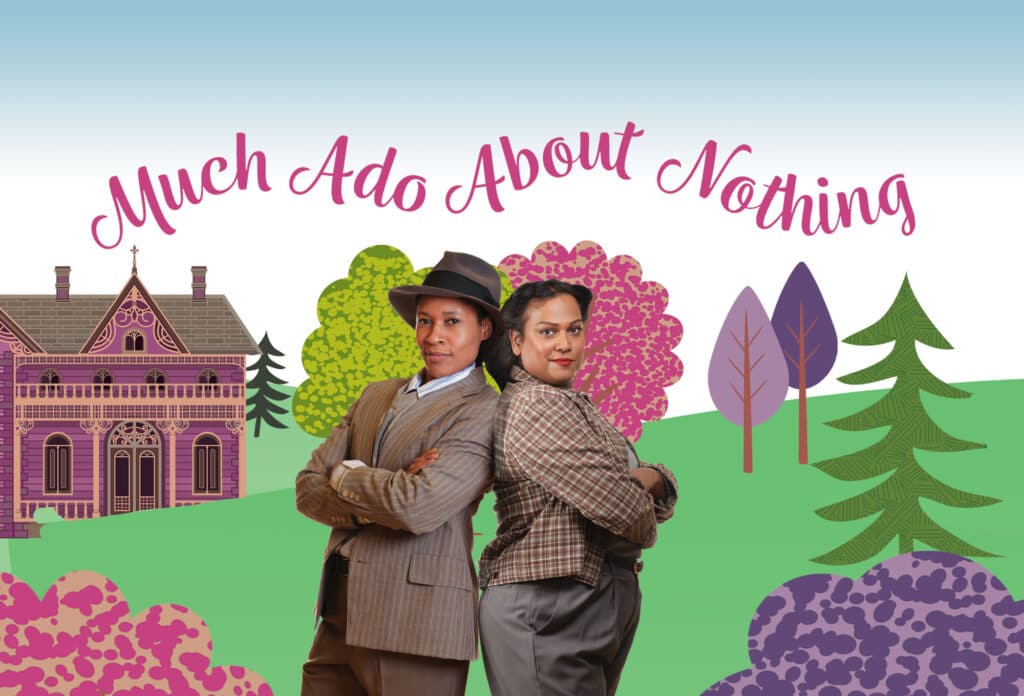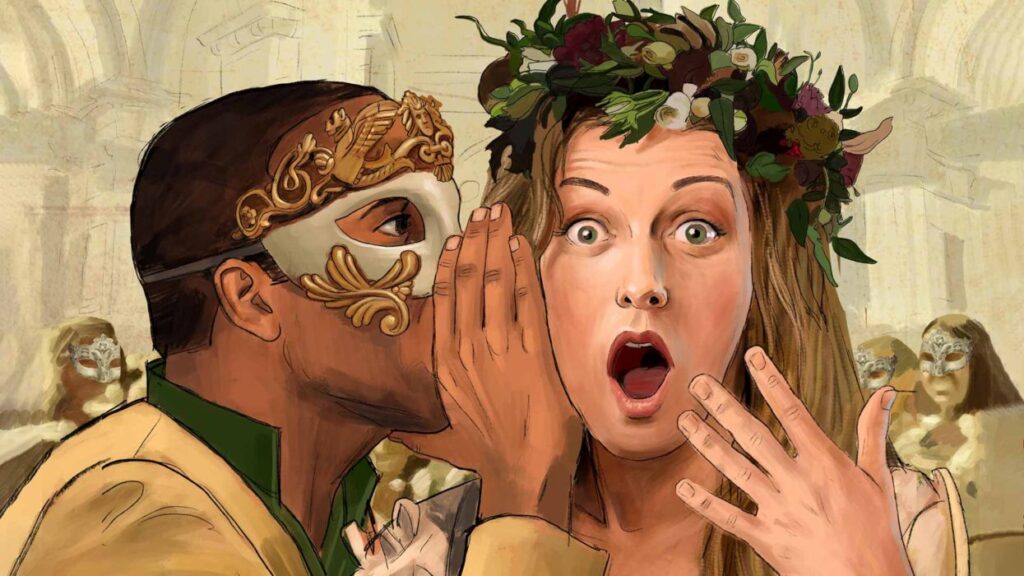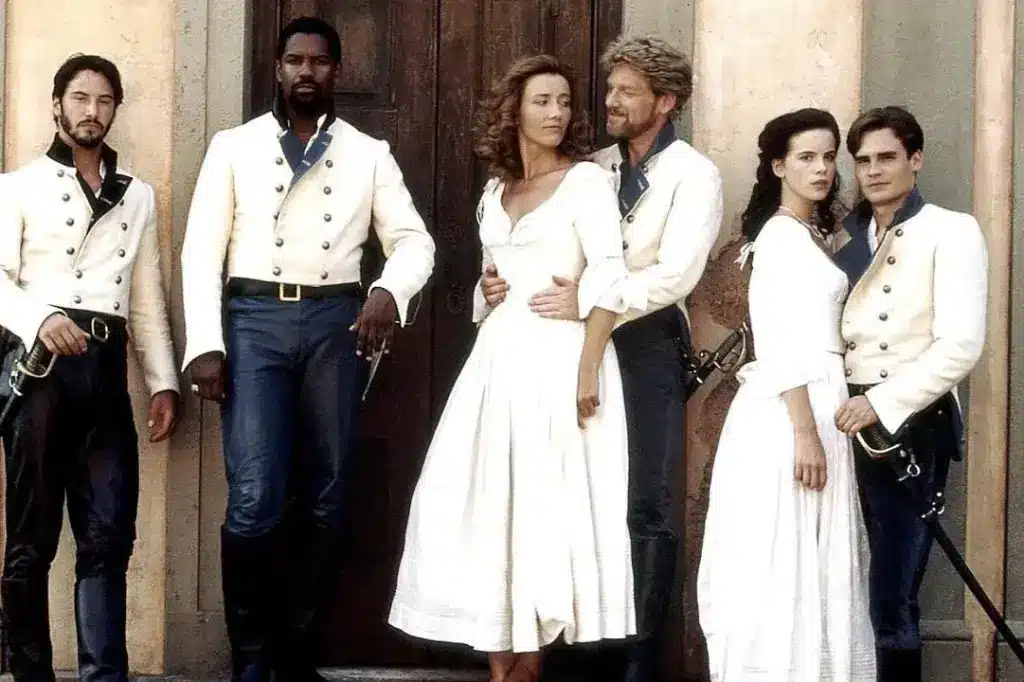Dramaturgy Fellow Series with Lexi Silva.

While Shakespeare’s Much Ado About Nothing has earned a reputation as a rollicking romantic comedy, its darker underpinnings categorize it as a problem play. To reference Production
Dramaturg Adam Versényi, a problem play is those works in Shakespeare’s canon that exhibit “greater complexity and irresolution.” I recommend reading Adam’s note which recounts a rich history of Much Ado and outlines the cultural zeitgeists of the Elizabethan era and postwar America in the mid-1940s, where PlayMakers’ production is set.
So, what’s the problem in this play? Leonato’s celebratory masque, Don Pedro’s matchmaking shenanigans, Beatrice and Benedick’s verbal sparring, and a double wedding are undercut by the public shaming of Hero in Act IV, Scene I, and her subsequent marriage to Claudio, her accuser. This problem raises a core dramaturgical question: how can PlayMakers stage a production of Much Ado that emphasizes Hero’s agency? Additionally, how can Hero’s agency shine through multiple frameworks across time? Staging a production that negotiates Elizabethan social constructs with post-WWII America and contemporary sensibilities about identity all while honoring Shakespeare’s text is no small feat. After a rigorous week of tablework under the visionary leadership of director Lavina Jadhwani, the company remains curious about how much the play can hold as we move into staging.

Although the process is in its early stages, I think that Hero’s journey in PRC’s production begins with a conversation about honor in Much Ado. During Claudio’s public humiliation of Hero on their wedding day in Act IV. scene I, he says:
She’s but the sign and semblance of her honor.
Behold how like a maid she blushes here!
O, what authority and show of truth
Can cunning sin cover itself withal! (Shakespeare 4.1. 33-36)
In a play where deception and manipulation play major roles in propelling the dramatic action, Claudio’s perception of Hero’s honor (or lack thereof) is almost entirely based on information from secondary sources. When Claudio’s worst fears are corroborated when he bears witness to the classic Shakespearean bed trick meant to frame Hero, he does not give her the benefit of the doubt. This leaves me wondering: are we to believe that Claudio is really so gullible? Or, can we interpret his lack of faith in Hero to be a product of a greater system of oppression? Personally, my money’s on the second one.

Contemporary audiences might interpret this injustice as a double standard enforced by the patriarchy. The circumstances of Hero’s alleged guilt, however, reflects Shakespeare’s own observations about Elizabethan society. In early modern England, the patriarchy still ruled despite having a female monarch on the throne. In that society, honor formed an integral part of the lives of men and women.
The establishment and defense of honor in this era was in accordance with the gender binary. The standards and codes of honor for women rely on their chastity, while men’s honor is determined by dueling, or other displays of courage. All this considered, Claudio’s sudden betrayal of Hero takes root in his greater embarrassment at being cuckolded in front of his superiors. Honor’s function in Much Ado is a crucial point of reference for how a person, or a character, defines themselves and is defined by others. In many ways, these gendered expectations remain prevalent, speaking to the enduring and timeless nature of Shakespeare’s texts (and, unfortunately, the persistence of the patriarchy).

Much Ado’s happily ever after, however, leaves many feeling dissatisfied. Why should Hero accept Claudio’s hand after all the suffering she endured because of him? Well, mainly, because Shakespeare says so. The same question of agency appears at the end of The Winter’s Tale when Hermione takes Leontes’ hand, or in Measure for Measure when Isabella takes the Duke’s. These unions are naturally complicated in a contemporary context wherein it appears that these women are too readily reconciled to the men who humiliated and exiled them a few acts prior. The justification for Hero and Claudio’s union for this cast and creative team, however, is still being worked out for the artists portraying them. This cast features a broad diversity of artists whose voices and instruments color Lavina’s cut of Much Ado with new contexts that we are discovering in real-time. This process presents an exciting opportunity to examine how Shakespeare’s plays are made to prosper in the present day.